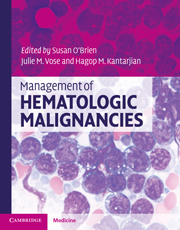Book contents
- Frontmatter
- Contents
- List of contributors
- 1 Molecular pathology of leukemia
- 2 Management of acute myeloid leukemia
- 3 Treatment of acute lymphoblastic leukemia (ALL) in adults
- 4 Chronic myeloid leukemia
- 5 Chronic lymphocytic leukemia/small lymphocytic lymphoma
- 6 Myelodysplastic syndromes (MDS)
- 7 Hairy cell leukemia
- 8 Acute promyelocytic leukemia: pathophysiology and clinical results update
- 9 Myeloproliferative neoplasms
- 10 Monoclonal gammopathy of undetermined significance, smoldering multiple myeloma, and multiple myeloma
- 11 Amyloidosis and other rare plasma cell dyscrasias
- 12 Waldenstrom's macroglobulinemia/lymphoplasmacytic lymphoma
- 13 WHO classification of lymphomas
- 14 Molecular pathology of lymphoma
- 15 International staging and response criteria for lymphomas
- 16 Treatment approach to diffuse large B-cell lymphomas
- 17 Mantle cell lymphoma
- 18 Follicular lymphomas
- 19 Hodgkin lymphoma: epidemiology, diagnosis, and treatment
- 20 Treatment approaches to MALT/marginal zone lymphoma
- 21 Peripheral T-cell lymphomas
- 22 Mycosis fungoides and Sézary syndrome
- 23 Central nervous system lymphoma
- 24 HIV-related lymphomas
- 25 Lymphoblastic lymphoma
- 26 Burkitt lymphoma
- Index
- References
18 - Follicular lymphomas
Published online by Cambridge University Press: 10 January 2011
- Frontmatter
- Contents
- List of contributors
- 1 Molecular pathology of leukemia
- 2 Management of acute myeloid leukemia
- 3 Treatment of acute lymphoblastic leukemia (ALL) in adults
- 4 Chronic myeloid leukemia
- 5 Chronic lymphocytic leukemia/small lymphocytic lymphoma
- 6 Myelodysplastic syndromes (MDS)
- 7 Hairy cell leukemia
- 8 Acute promyelocytic leukemia: pathophysiology and clinical results update
- 9 Myeloproliferative neoplasms
- 10 Monoclonal gammopathy of undetermined significance, smoldering multiple myeloma, and multiple myeloma
- 11 Amyloidosis and other rare plasma cell dyscrasias
- 12 Waldenstrom's macroglobulinemia/lymphoplasmacytic lymphoma
- 13 WHO classification of lymphomas
- 14 Molecular pathology of lymphoma
- 15 International staging and response criteria for lymphomas
- 16 Treatment approach to diffuse large B-cell lymphomas
- 17 Mantle cell lymphoma
- 18 Follicular lymphomas
- 19 Hodgkin lymphoma: epidemiology, diagnosis, and treatment
- 20 Treatment approaches to MALT/marginal zone lymphoma
- 21 Peripheral T-cell lymphomas
- 22 Mycosis fungoides and Sézary syndrome
- 23 Central nervous system lymphoma
- 24 HIV-related lymphomas
- 25 Lymphoblastic lymphoma
- 26 Burkitt lymphoma
- Index
- References
Summary
Introduction
Follicular lymphoma (FL) is the most common type of indolent B-cell lymphoma diagnosed in the United States. A better understanding of the biology of disease and the development of novel targeted agents are challenging prior dogmatic concepts regarding the standard therapeutic approach to FL.
In recent years, the lymphoma field has seen significant progress with respect to the identification of clinical, tumor-associated, and host-associated prognostic factors, as well as the development of novel functional imaging (e.g., positron emission tomography [PET] scans). Improvements in molecular diagnostics allow a clearer distinction between various lymphoma subtypes. Perhaps the single most important advance has been the development and integration of monoclonal antibodies (mAbs) into the treatment of B-cell lymphoma which has resulted in a steady improvement in progression-free survival (PFS) and overall survival (OS) of patients. This chapter summarizes the advances achieved in the last two decades that have led to the current approach and management of patients with FL.
Pathogenesis of FL
As technology and its applications have improved over the last two decades, there has been a parallel improvement in our understanding of the molecular mechanisms responsible not only for the development of FL, but also to explain its clinical heterogeneity. Ontologically, FL arises from germinal B cells usually as a result of deregulation in the apoptotic machinery. FL was one of the first lymphomas in which a molecular defect was defined.
- Type
- Chapter
- Information
- Management of Hematologic Malignancies , pp. 338 - 366Publisher: Cambridge University PressPrint publication year: 2010



